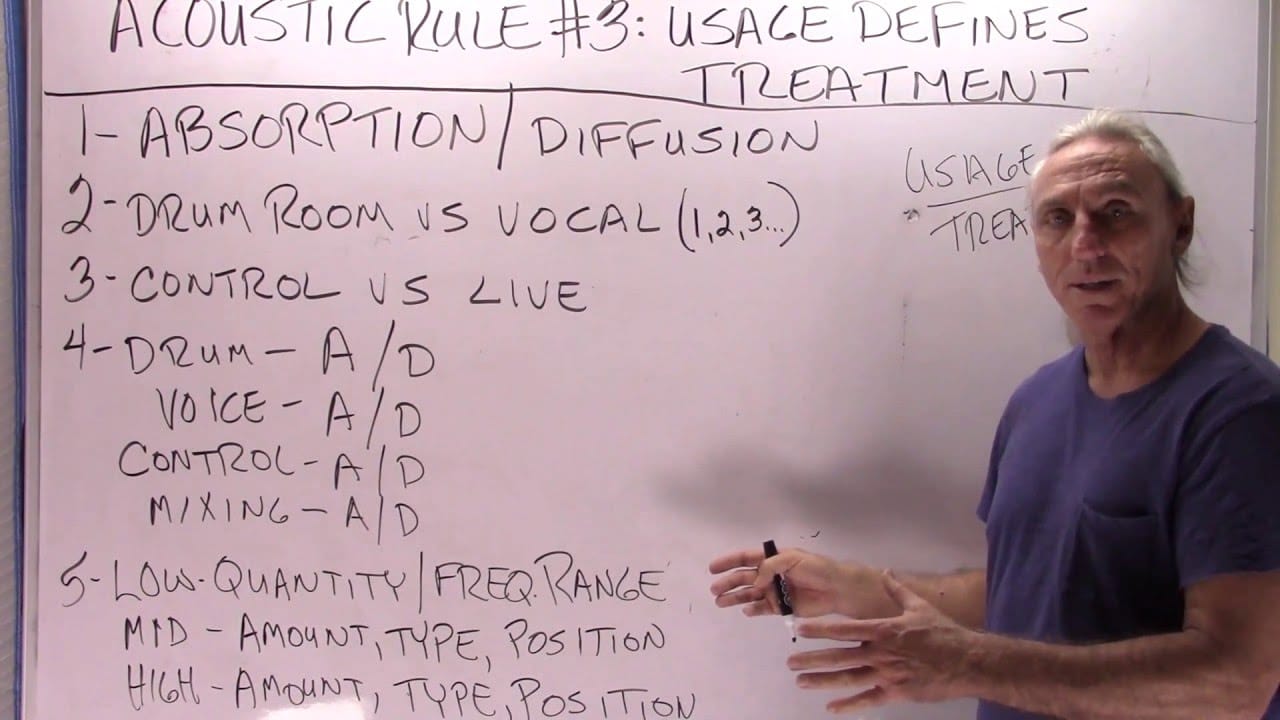Today we are going to talk about acoustic rule number 3, which is: the usage of the room defines the treatment. This is very, very critical. A lot of people are very confused about what treatment to use for this room, that room and the other room and it is not that difficult if you just step back a little bit and take a deep breath. So we are going to take a deep breath and define some terms here and see if we can clarify this issue for you.
We have two technologies that we can use, absorption and diffusion. That is it, there are no others. And it doesn’t matter what names company calls their products, even our names: diaphragmatic absorption, it’s an absorption process. Quadratic diffusion, a diffusion process, a diffusion technology. That are the only two we have. Now there are combinations of those, but there are still the two main types that we have to work with. Those are the two acoustical tools that we have to work with. One could argue that the electronic signal processing room is another treatment technology, but we won’t discuss that here, we will save it for another time. So with those two technologies that we have to use we have to remember that it’s all about the use. A drum room is going to be drastically different than a voice room. A vocal room for one singer is drastically different in usage requirement and treatment technology than two or three or four or ten. So, usage and treatment, you always have to keep this paradigm in mind. It is always what are we doing in the room and how we are going to treat it to complement the usage, and what are we trying to get out of it?
So, we have our two technologies. Let’s look at a drum room. In a drum room we are going to use absorption and diffusion? We are going to use absorption for sure, because we have a lot of low frequency energies and most rooms are not large enough to handle that energy. Diffusion can be used, we use it in Sacred Ground a lot of times on the rear wall. It is really good for the china, snare and tom, the upper frequencies, it really helps to add a little air and separation at the microphone position. So we have our drum room, absorption and diffusion, our vocal rooms. Mainly absorption that we see a lot of times, but diffusion is a popular technology now and we have experimented with that, we are going to start doing some videos and post some audio examples on our website of instruments, microphone and diffusion. We do a lot of experimenting with voice and diffusion, and what we are finding is that the engineers tell us that are our setup keeps the vocal sound pure longer in the signal processing process. They don’t have reverb, they don’t have delay immediately. It’s good right out of the gate and that’s wonderful. If you can get the source as pure as possible then you don’t need all that signal processing and manipulation.
So all usages have their various degrees and levels of absorption and diffusion, are two main technologies. Low frequency energy is all about how much square footage do I need in the room to manage the low frequency issues that are in that room which is based on it’s size and it’s volume. It is also based on the amount of energy the speakers are putting into it. There is a 2 dB gain between 12 inch subwoofer and a 10 subwoofer. That two dB of energy, when you are talking about frequency response, can have a big impact on the low end. 2 dB could cause maybe a 8 dB rise here in the lower end. There is not a one to one correspondence. Once again, depending on room size and volume. You have to be very, very careful. And the middle frequencies is all about what we are going to use, absorption and diffusion, what type are we going to use. Are we going to use a broad band absorption, are we going to use a lower octave diffusion sequence?
It all depends on room usage, what you are trying to accomplish. So, high frequencies are always about how much absorption do we use, how much diffusion do we use, what type and, more importantly, where do we put it. Because the microphone hears things that our ears don’t, so if it is a live recorded situation or a playback, mixing, monitoring, mastering situation. It is different, everything is different, there is no one size fits all. So if you first define what you are trying to do with in the room, and don’t try to do too many things in one room. Obviously for sake of illustration, a drum and a vocal room couldn’t be more different. You would not try to record vocals in a drum room, or you might, but you definitely wouldn’t record drum in a vocal room. So usage and treatment have to be related there, is a synthesis, a balance, a synergy between those. And you always have to determine how much low frequency absorption you need, where to put it, and what is the type to use depending on the magnitude of the problem, and the same time holds true for middle and high frequency. So: usage defines treatment.
—
This is an unedited transcript from our video series from Acoustic Fields. There will be some errors in grammar and sentence structure that occur during this translation process.
For complete understanding and comprehension, please view the video which is included in this text. For any additional information regarding this topic or others relating to room acoustics, please contact us directly at:
P: 520 – 392 – 9486







